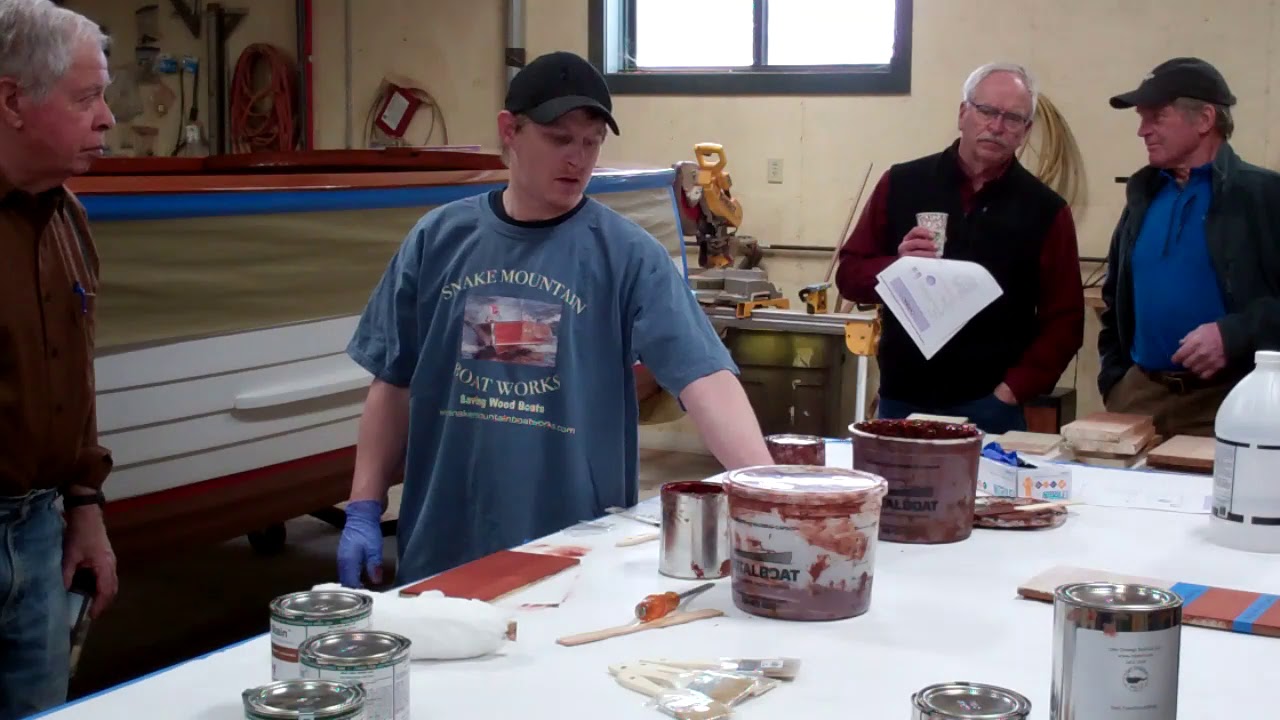Snake Mountain Boatworks hosted its annual winter hands-on workshop for ACBS, and especially its Lake Champlain chapter on Saturday, February 2, 2019. We introduced folks to Jel’d wood stain,, or that is RJ and Joe did. The guys enticed most people to take a lap around the staining table.
SMB is now using Jel’d stain exclusively unless an owner insists on us applying Interlux Interstain Filler Stain.
Here is why and where you can purchase a stain we find to be truly exceptional.
Paste Filler Stain
- Filler stains are made to color the wood and also fill the grain of open grained woods, such as Mahogany.
While they do have grain filling qualities, they do not fill the grain all the way.
- Traditional varnishes “flow out” or “sink into” the grain after a few months, which requires adding varnish after the first season to sustain a perfectly glossy finish.
- Once the follow-up coats of varnish are applied the boat will retain its glossy finish.
Jel’d Stain
Many colors are available
- Jel’d stain is available in twenty-five colors from Wood Kot
The red, brown and dark mahogany, as well as the walnut match, or come very close to standard antique and classic wood boat colors.
- Mike Mayer, who owns Lake Oswego Boat Company in West Linn, OR, is the exclusive mixologist and supplier of custom-mixed Jel’d stain that matches many wood boat makes’ OEM stain colors exactly. Mike can be reached by email, [email protected], or via his Web site: www.loboat.com.
- Century
- Chris-Craft Pre-War
- Chris-Craft Post-War
- Chris-Craft Blonde
- Chris-Craft Dark
- Gar Wood
- Hacker-Craft
- Interlux Interstain 42
- Interlux Interstain 573 (CC Post-War)
Use it right out of the can
- Filler stains must be mixed in a separate container after you scrape all the solids out of the can.
- Evaporation causes filler stain’s final mixed consistency to change continually during the stain process.
- Thinner must be added as a result. Maintaining exactly the same consistency through a project, especially in warmer weather, is difficult as a result. Maintaining consistent color is rendered quite challenging as a result.
- That the stain cannot be scrubbed until it flashes adds additional complexity to the process. Not waiting long enough produces streaking. Waiting too long can force you to reach for thinner to liquify the already-applied-and-flashed stain anew.
- Even when you don’t stop with filler stains. it is difficult to maintain consistency in color and avoid blotches.
Easy to apply
- Jel’d stain can be applied easily with a rag or a brush.
- Unlike filler stain, applying Jel’d stain can even stop in the middle and be resumed later.
- Timing is critical when removing filler stain, but not for Jel’d stain. There is no waiting for Jel’d stain. Since it does not flash, a second person can follow immediately behind the one applying the stain, rubbing it into the wood in a circular motion and then wiping off the excess stain with the grain immediately.
- The process produces a uniform color because no waiting for and judging of the degree of flashing is required.
Sand out scratches while Jel’d stain is being applied
o There is nothing worse than finding cross-grain scratches and sanding marks while applying stain. o Scratches or blemishes can be sanded out; new Jel’d stain can be re-applied immediately; and everything will blend. Two to Three Times More Coverage o Jel’d stain will cover 1,250 to 1,500 square feet per gallon.
Fast drying
- Wood Kote specifies “at least four hours,” but Mike Mayer recommends waiting at least 24 hours before applying sealer, and even longer in colder temperatures.
Whether we are applying Interlux Interstain Filler Stain or Jel’d stain, we allow a full two to four days cure time to ensure that applying CPES does not partially reliquify and then drag the stain.

